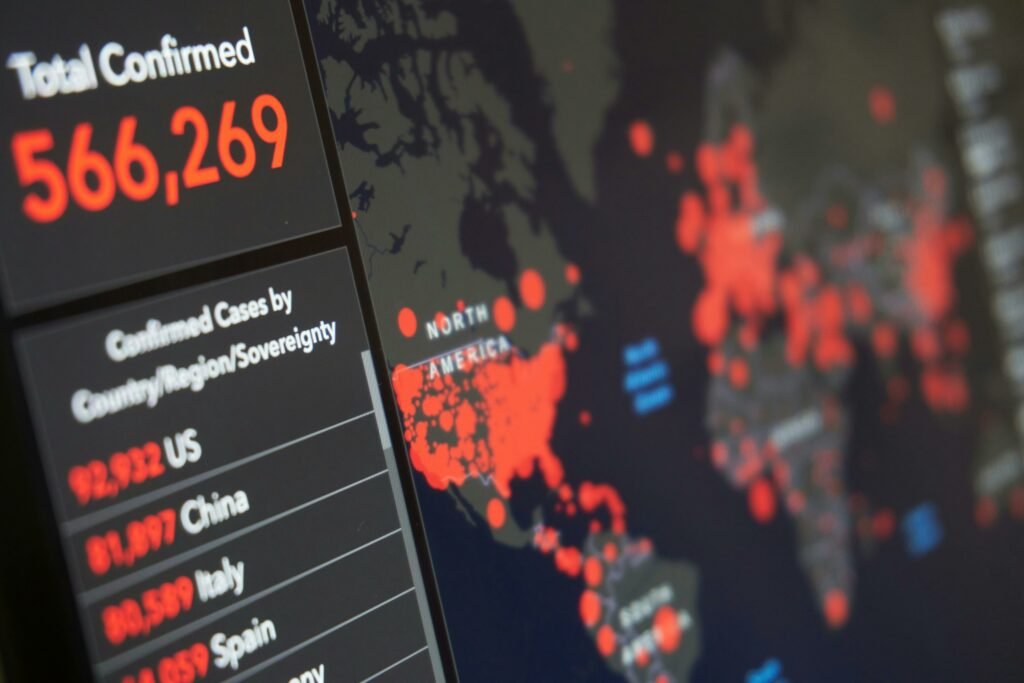In today’s rapidly changing world, businesses face unprecedented levels of uncertainty and volatility. The ability to navigate these uncertain times and make informed decisions is crucial for long-term success. This is where scenario planning comes in. Scenario planning is a strategic foresight technique that helps organizations anticipate potential challenges, strategize for multiple plausible futures, and mitigate risks effectively.
Strategic foresight involves analyzing trends, drivers, and uncertainties to gain insights into possible future scenarios. By assessing future uncertainty and identifying key uncertainties, organizations can develop robust risk mitigation strategies that protect against potential disruptions and capitalize on emerging opportunities.
Key Takeaways:
- Scenario planning is a strategic tool that helps organizations navigate uncertainty and make informed decisions.
- Strategic foresight and future uncertainty analysis are critical components of scenario planning.
- Risk mitigation strategies can be developed by identifying potential challenges and developing flexible strategies.
- Scenario planning promotes agility, resilience, and long-term success in the face of uncertainty.
- By utilizing scenario analysis tools and techniques, organizations can effectively manage uncertainty and position themselves for future success.
Scenario Planning for Uncertainty : Navigate the Future
The Benefits of Scenario Planning
Scenario planning offers multiple benefits to organizations. Firstly, it allows leaders to explore and rehearse plausible futures before they actually occur, enabling them to recognize weak signals of impending change sooner. Secondly, it encourages contingency planning and future-proofing strategies to ensure that the organization is prepared for various scenarios. Thirdly, scenario planning challenges executives’ assumptions and mental models, creating a common language about the future and promoting flexible strategies. Lastly, it helps organizations build resilience and agility in the face of uncertainty by identifying risks and developing effective risk management techniques.
Various scenario analysis tools, models, and techniques are available to facilitate the scenario planning process.
| Tool Name | Description |
|---|---|
| SWOT Analysis | A strategic planning technique used to evaluate an organization’s strengths, weaknesses, opportunities, and threats. |
| PESTEL Analysis | An analysis framework that examines political, economic, social, technological, environmental, and legal factors affecting an organization. |
| Scenario Planning Software | Specialized software that assists in creating and analyzing different scenarios, often incorporating data-driven modeling and simulations. |
| Delphi Method | A group facilitation technique that gathers inputs from multiple experts to identify and assess potential scenarios. |
| War Gaming | A simulation-based technique where participants role-play different scenarios to assess their strengths and weaknesses. |
These tools enable organizations to conduct comprehensive scenario analysis, identify potential risks, and make informed decisions for future success.
The Process of Scenario Planning
The process of scenario planning involves several steps that enable organizations to navigate uncertainty and strategically plan for the future.
1. Exploring Multiple Possible Futures: Scenario planning starts by exploring a wide range of possible futures and capturing uncertainties. This involves considering various factors such as market trends, technological advancements, and geopolitical changes.
2. Distilling Uncertainties into Alternative Futures: Once the uncertainties are identified, they are narrowed down and distilled into a few internally consistent, relevant stories that describe alternative futures. These stories serve as the foundation for developing business scenarios.
3. Developing Business Scenarios: Business scenarios can focus on macro and industry uncertainties or be more project-oriented. They provide detailed narratives that help organizations understand the potential impacts of different future scenarios on their operations, strategies, and goals.
4. Rehearsing and Testing Strategies: Leaders rehearse and test their current strategies against the developed scenarios. This process helps identify potential vulnerabilities, areas for improvement, and the need for adaptation. It also allows organizations to align their strategies with the future challenges and uncertainties they may face.
5. Injecting Flexibility into the Strategy: To effectively navigate uncertainty, it is crucial to inject flexibility into the strategy. This means creating strategies that do not rigidly lock the organization into specific courses of action. Instead, they allow for adjustments and alternative approaches based on the unfolding future.
6. Strategic Planning and Adaptation: Throughout the scenario planning process, strategic planning and adaptation strategies play a vital role. Strategic planning ensures that the organization’s goals and objectives align with the identified scenarios. Adaptation strategies enable organizations to respond promptly and effectively to changing circumstances, ensuring business resilience and success.
By following this process, organizations can proactively prepare for uncertainty, make informed decisions, and position themselves for long-term growth and sustainability.
Tools and Techniques for Scenario Analysis
Scenario analysis is a vital process for organizations to effectively analyze and strategize for different scenarios. By utilizing various tools and techniques, companies can navigate uncertainty and make informed decisions. Let’s explore some of the key tools and techniques used in scenario analysis:
Trend Analysis
Trend analysis is a valuable technique that helps identify patterns and potential future developments. By analyzing historical data and identifying trends, organizations can anticipate potential future scenarios and adapt their strategies accordingly. This analysis provides valuable insights into emerging market trends, customer preferences, and industry shifts, enabling businesses to stay ahead of the curve.
Contingency Planning
Contingency planning involves preparing alternative action plans to address specific scenarios and minimize disruption. This technique helps organizations develop responsive strategies that can be implemented quickly and effectively in the face of unexpected events. By considering a range of possible future outcomes, businesses can mitigate risks and ensure business continuity.
Future Scenario Planning
Future scenario planning goes beyond trend analysis to develop detailed narratives and explore the implications of different possible futures. This technique helps organizations envision a range of scenarios and understand the potential impacts on their operations, customers, and markets. By creating vivid scenarios, businesses can strategically prepare for different situations and proactively shape their future strategies.
Strategic Scenario Planning
In strategic scenario planning, organizations analyze the impact of specific scenarios on their long-term strategy. By considering different future possibilities, companies can evaluate their current strategic direction and identify potential gaps or vulnerabilities. This analysis enables organizations to make adjustments, refine their strategies, and ensure alignment with future scenarios.
Uncertainty Analysis
Uncertainty analysis techniques are crucial in scenario planning as they assess the level of uncertainty associated with different scenarios and identify related risks. By quantifying and analyzing uncertainties, organizations can prioritize their response strategies and allocate resources effectively. This analysis provides a deeper understanding of potential risks and their potential impact, guiding decision-making processes.
These tools and techniques empower organizations to navigate uncertainty, make informed decisions, and build resilience. By combining trend analysis, contingency planning, future scenario planning, strategic scenario planning, and uncertainty analysis, businesses can effectively assess their current state, adapt to changing circumstances, and thrive in an unpredictable future.
Managing Uncertainty and Making Decisions
Scenario planning is a crucial component of effective risk management and decision-making processes in organizations. By considering a range of possible futures and evaluating their implications, leaders can make informed decisions that align with their business strategies.
Identifying potential risks and uncertainties is a fundamental step in managing uncertainty. Scenario analysis allows organizations to assess the performance of different strategies under various scenarios, helping them select the most appropriate course of action. This analytical approach enables leaders to anticipate challenges and develop effective risk management strategies.
Uncertainty management strategies play a vital role in decision-making processes. These strategies focus on building adaptability and flexibility into decision-making, allowing organizations to respond effectively to changing circumstances.
Overall, scenario planning provides a structured approach to managing uncertainty and considering a range of potential outcomes. By utilizing scenario analysis and decision-making techniques, organizations can enhance their decision-making processes and navigate uncertainty with confidence.
“Scenario planning allows organizations to anticipate challenges, develop risk management strategies, and make informed decisions in an ever-changing business environment.”
Implementing scenario planning involves an iterative process that requires continuous evaluation and adaptation. It is a dynamic approach that enables organizations to proactively address uncertainty, strengthen their business strategies, and position themselves for success.
Case Study: XYZ Corporation
To illustrate the benefits of scenario planning in managing uncertainty and making informed decisions, let’s consider a case study of XYZ Corporation, a global manufacturing company. XYZ Corporation faced significant uncertainties due to geopolitical tensions and disruptions in the supply chain.
By conducting scenario analysis, XYZ Corporation identified various potential scenarios, including trade restrictions, political instability, and increased competition. This analysis allowed the company to develop risk management strategies and contingency plans to mitigate the potential impact of these scenarios.
“Scenario planning enabled XYZ Corporation to adapt its supply chain, identify alternative sourcing options, and diversify its operations, ensuring business continuity and resilience.”
Through scenario planning, XYZ Corporation enhanced its decision-making processes by evaluating the performance of different strategies under different scenarios. This analysis enabled the company to select the most appropriate course of action, ensuring its long-term sustainability and success.
The Role of Monitoring and Early Warning Systems
Monitoring and early warning systems play a critical role in scenario planning and uncertainty management. As organizations navigate the complex landscape of uncertain futures, it is essential to regularly monitor external and internal factors that could impact their strategies and scenarios. By assessing risks, identifying early warning signals, and developing strategies to mitigate potential impacts, organizations can proactively prepare for a range of possibilities.
One of the key aspects of the scenario planning process is ongoing monitoring of indicators that are specific to the organization’s strategy and scenarios. This allows organizations to stay ahead of changes, identify potential challenges, and adjust their strategies accordingly. By continuously tracking the relevant factors, organizations can actively manage uncertainty and make more informed decisions.
“Monitoring and early warning systems provide organizations with valuable insights and help them adapt their strategies in real-time,” says Sarah Thompson, a leading expert in risk assessment and scenario planning. “By keeping a pulse on the evolving landscape, organizations can proactively respond to emerging risks and capitalize on new opportunities.”
Effective monitoring and early warning systems are essential for successful uncertainty planning and business resilience. They provide organizations with the necessary information and insights to anticipate and respond to changes, ensuring that their strategies remain relevant and effective in the face of uncertainty.
“Monitoring and early warning systems allow organizations to be proactive rather than reactive,” adds Thompson. “They provide the foundation for agile decision-making, giving organizations the confidence to navigate uncertain futures with greater certainty.”
Benefits of Effective Monitoring and Early Warning Systems
- Early identification of potential risks and opportunities
- Proactive adaptation of strategies based on changing circumstances
- Improved decision-making through real-time insights
- Enhanced business resilience and agility
- Optimized resource allocation
By incorporating monitoring and early warning systems into their scenario planning process, organizations can strengthen their ability to navigate uncertainty, seize opportunities, and mitigate risks. As the future becomes increasingly unpredictable, investing in effective monitoring and early warning systems is crucial for long-term success.
Conclusion
Strategic planning plays a vital role in helping organizations navigate uncertainty and ensure future success. By embracing scenario planning, businesses can anticipate challenges and develop flexible strategies to adapt to changing circumstances. This approach allows leaders to explore multiple possible futures, empowering them to make informed decisions and mitigate risks effectively.
Scenario planning enables organizations to build resilience by considering a range of potential outcomes and developing strategies to address them. By utilizing scenario analysis tools and techniques, leaders can gain valuable insights to improve their decision-making processes. This proactive approach to risk management helps organizations position themselves for success in an unpredictable future.
The future is inherently uncertain, but by embracing scenario planning, organizations can proactively forecast potential challenges and opportunities. Strategic planning, risk mitigation, and future forecasting are vital components of this process. By continuously monitoring indicators and developing early warning systems, organizations can stay ahead of the curve and adjust their strategies accordingly.
FAQ
What is scenario planning for uncertainty?
Scenario planning for uncertainty is a strategic process that involves envisioning and strategizing for multiple possible futures. It helps organizations anticipate challenges, shape strategies, and secure their future by considering different scenarios and potential outcomes.
What are the benefits of scenario planning?
Scenario planning offers several benefits to organizations. It allows leaders to explore and rehearse possible futures before they happen, encourages future-proofing strategies, challenges assumptions to promote flexible strategies, and helps build resilience by identifying risks and developing effective risk management techniques.
What is the process of scenario planning?
The process of scenario planning involves exploring multiple possible futures, distilling uncertainties into relevant stories, testing strategies against scenarios, injecting flexibility into the strategy, and ensuring adaptability to different futures.
What tools and techniques are used in scenario analysis?
Scenario analysis utilizes various tools and techniques such as trend analysis, contingency planning, future scenario planning, strategic scenario planning, and uncertainty analysis. These tools help organizations analyze and strategize for different scenarios.
How does scenario planning help in managing uncertainty and making decisions?
Scenario planning helps manage uncertainty by considering a range of possible futures and evaluating their implications. It helps identify risks, develop risk management strategies, and make informed decisions based on the performance of different strategies under different scenarios.
What is the role of monitoring and early warning systems in scenario planning?
Monitoring and early warning systems play a critical role in scenario planning by regularly assessing factors that could impact strategies and scenarios. These systems help organizations stay ahead of changes, identify potential challenges, and adjust strategies accordingly to enhance business resilience.
How does scenario planning support strategic planning and risk mitigation?
Scenario planning provides a structured approach to managing uncertainty and considering a range of potential outcomes. By identifying potential risks and uncertainties, organizations can develop effective risk management strategies, improve decision-making processes, and position themselves for success in an unpredictable future.










![How to Improve Employee Welfare? [7 Ways] 11 How to Improve Employee Welfare](https://zoets.b-cdn.net/wp-content/uploads/2024/02/pexels-alexander-suhorucov-6457577-scaled-e1708707251724.jpg)
![Saudi Oil Industry Key Stats Unveiled [2024] 12 Saudi Oil Industry Key Stats](https://zoets.b-cdn.net/wp-content/uploads/2024/02/h.jpg)